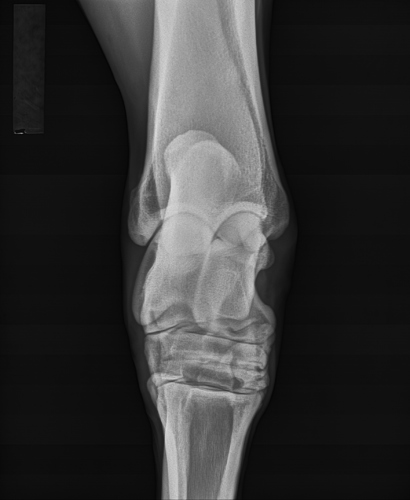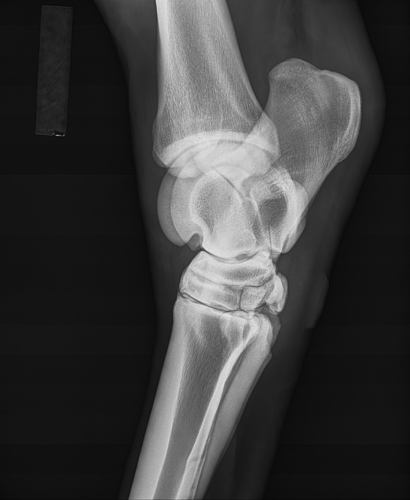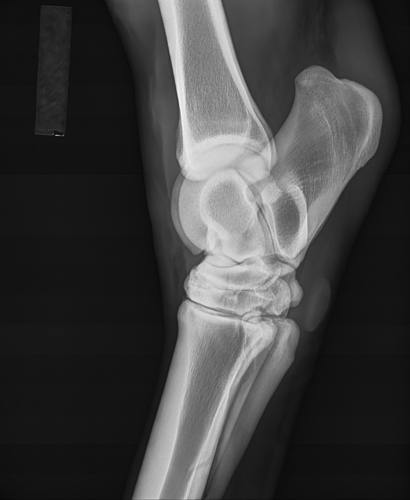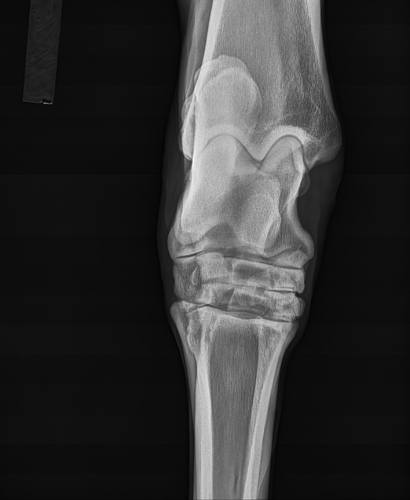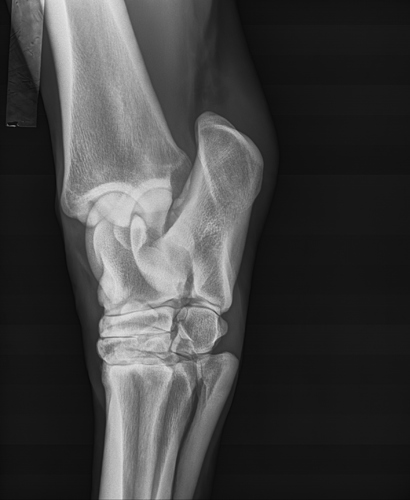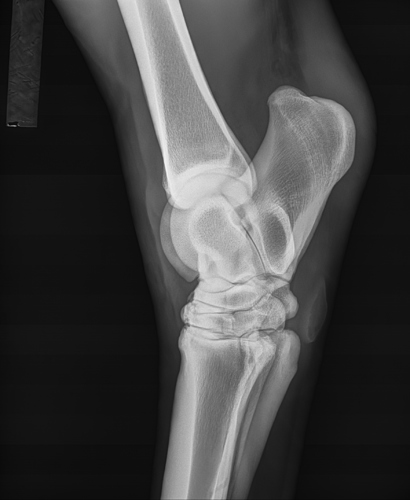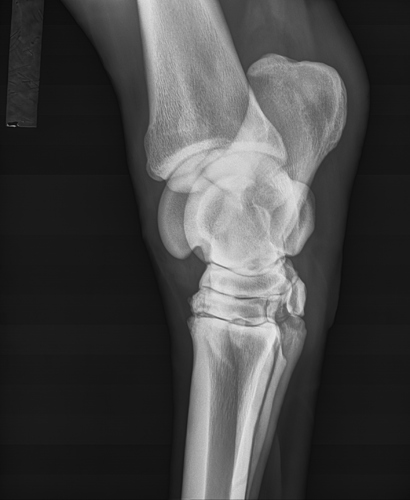Just to throw in something else: does your bridle fit? I’ve heard of horses who were NQR because they were uncomfortable with their bridle applying pressure in some uncomfortable places. Something as simple as a buckle rubbing or the browband too tight.
Honestly, if the front feet are unbalanced you can almost bet the hind feet will be too, and that they are high on the inside. Imbalances in the hind feet can be trickier to see than in the fronts, and imbalanced hind feet almost always cause soreness in the hocks, stifle, sacro and back.
Post some pics of the hind heels, taken looking from the heel towards the toe, and lining up the heel with the toe (like you’re looking over a glass of water and lining up the front and back of the glass).
Like this:

I actually sent videos to Jec and asked her to put together a plan … that has been so very well worth it.
Also, I did want to mention that in the process of trying to figure this all out, I did a full nuclear scan, MRIs of front feet, xrays of all feet, hocks, fetlocks, stifles, ultrasound of SI and anything else we could think of. Everything has looked good all along and while the data is important, it was a ton of $$$ that only left everyone at a loss for why he didn’t feel right. It was only when I turned my attention to his structural muscles and changed our work outs that I’ve seen progress.
Wow! If I ever reincarnate as a horse I hope you’re my owner! Your horse is very lucky to have someone so thorough. Trying to diagnose lameness is such a tangled web.
Ok here is a couple videos of her longing from 8/4, apologies for the shakiness.
Left: https://youtu.be/VfvaC_waNCI
Right: https://youtu.be/B6w3Es3guhA
Some ridden trot work from 6/22, pls be nice: https://youtu.be/_GCaysB2oqY
And finally here are all the hock x rays! I have no idea which leg is which.
And to answer a couple questions that came up, she is on 24/7 turnout and will always be as long as she’s with me because i’m a turnout freak.
I have switched farriers despite the vet thinking her feet are not a big deal so I’m hopeful that a new farrier can help get her a little bit more comfy in her feet and that might help. I don’t have the x rays that were taken the other day yet but you can reference this thread to see some hoof pics from late June: Does anyone want to look at my horse's feet again?
This is very interesting… can I ask why you say never chiro?
Actually this is one thing that has helped in her not being SO reactive under saddle, I had been riding in just like a cheapo regular hunter bridle and switched her to a Micklem (thank you eBay) and she def was just a little bit more willing and more happy under saddle. It wasn’t like a miracle cure or anything but it did seem to help a tiny bit with her comfort level.
This is what I would think too… but I really don’t know.
Overall like I know that there’s a lot more diagnostics that can be done, but 1) I am somewhat limited in my budget, although my credit card has plenty of room  and 2) It’s just really weird to me that two vets now seem to have no clear next step to offer when it comes to diagnostics when I feel like, there’s still so much to explore. Bc in reality like the horse is CLEARLY lame now, unlike before where you couldn’t really see anything except just like dinky movement and her protests at going forward.
and 2) It’s just really weird to me that two vets now seem to have no clear next step to offer when it comes to diagnostics when I feel like, there’s still so much to explore. Bc in reality like the horse is CLEARLY lame now, unlike before where you couldn’t really see anything except just like dinky movement and her protests at going forward.
I am still super worried that it is the hind suspensory honestly!! I kinda wish I had just insisted on an ultrasound that day.
But yes I think in the short term I’ll definitely start focusing more on the pain management, and keep a super close eye on her feet and continue to try to advocate for her there because I do think that’s at least contributing to the overall body soreness, and I’ll get her tested for EPM and Lyme as well.
Nice horse, lovely rider.
I saw foot soreness related. She is not tracking evenly behind and is walking like she is bilaterally footsore behind.
Just wanted to comment that my vet (who is well known in the area for lameness diagnosis) never does any injections until the horse is tested for Lyme. Not an expensive test and you don’t want to inject a joint unnecessarily.
He also says that a huge number of lameness issues he treats are feet related. I don’t know how your vets assessed your horse’s feet, but here’s an interesting article:
Good luck, she’s a cute horse and she sounds very willing and brave.
Yes! I feel like for the hind feet it’s most visible at the walk, like she’s just dragging her hind end along with the front feet and not really using it at all.
Yes saw the same. And not tracking up at all very short strided. Rider was as kind and sympathetic as possible! Kudos.
Thank you both  she’s definitely trained me in how she prefers to be ridden LOL princess gets what she wants!!!
she’s definitely trained me in how she prefers to be ridden LOL princess gets what she wants!!!
I can see NQR in front and behind. Those X-rays are pretty rough, but based on the video I’m still not convinced the hocks are the only thing.
Hi SSP - I had tried chiro multiple times but he was extremely reactive. I think his muscles were so sore that the chiropractic manipulations - and in particular the needles in his tight, hard, sore muscles – was more than he could stand. It was beyond just uncomfortable - he was dangerous, and this is the sweetest, most tolerant horse you could imagine. At the end of the day, I just didn’t think that modality was helpful for his issues around muscle pain.
Ahhh okay got it. Now I’ve always heard basically that you need to be super careful with chiropractors and just make sure they know what they’re doing before picking one, would you say massage is the same way or is it a little more like, ~margin for error~ I guess?
If your vet feels so strongly that the hocks are the source of the lameness, he needs to block the hocks to make sure lameness improves before suggesting an invasive procedure like arthrodesis.
Edited because I made it to the xrays. She’s definitely lame on the right hind, she looks footy on both fronts. The xrays are actually pretty bad. Still stand behind my original comment re: blocking. If she does, in fact, block IA to the hock, you could try Osphos, shockwave, shoeing changes, Adequan, Prostride, Alpha 2, etc.
Agree. Also, there are shoeing changes you can make behind to help hock pain. Lots of things to try before arthrodesis.
I have learned the hard way not to buy horses who I think I can fix. Sometimes, the day you try them is the best they will ever be. Did the attending PPE vet give a reason for the horse being lame on both fronts, and still advise you to buy a lame horse?
The attending vet also said she flexed unsound on a hock, did rads and said they looked good, but now another vet says there’s significant arthritis there in just a matter of months? Something doesn’t add up here - I think your attending PPE vet failed…
I’m so sorry you’re going through this. I hope you can find a trusted vet to help guide you - I’ve had lots of vets tell me to buy X horse but on review with my own vet and radiologist a host of issues have been pointed out. It’s a minefield…
Any vet that makes the statement anything will “fix it 100%” even with full diagnostics and blocks ground up is spouting BS, Without any proper diagnostics that statement is borderline scamming cash strapped clients. S/he can only guess at the likely success, partial success or failure of any procedure, diagnostics or not, and send the bill. Often end up spending hundreds or thousands treating the wrong thing while whats really wrong gets worse not to mention discomfort and down time for the horse.
Maybe its best to give her more time off while dealing with one of the things you can see is wrong with a competent farrier. Give it 2 or 3 cycles and see. 10 months isnt all that long if she was screwed up when you got her, Dr Green and tincture of time can be at least part of the answer.
The suggestion of trouble higher up in the hips, lower spine and pelvic area should not be dismissed along with rear suspensory trouble. These mimic numerous other conditions and lead to wasting much time and money that wont solve a thing.

